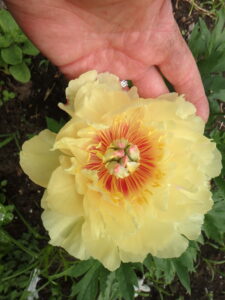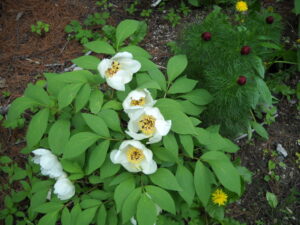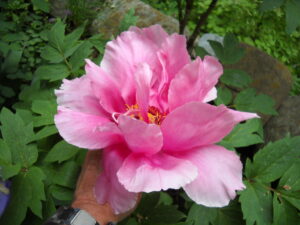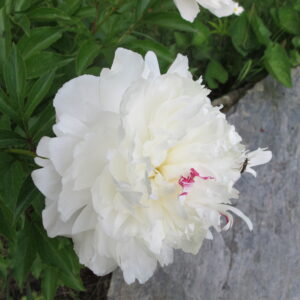Everything You Wanted to Know About Peonies, but Were Afraid to Ask
Posted on Tuesday, June 8, 2021 · Leave a Comment

Itoh peony ‘Garden Treasure’ in my garden last June
If you don’t have a peony, I’m surprised. If you don’t have three, you should. They are blooming now, and this is a great time to buy them. Go to your local garden center or family-run plant nursery and buy some more, no matter how many you have. Buying in bloom means you can see the color of the blossoms, and sample the fragrance. Not all are very fragrant, but some are so lovely they might make you swoon.
When my wife Cindy Heath moved in with me in 2019, she insisted on bringing many plants – including her Dad’s favorite peonies and several others. I walked around recently to count how many peonies we have together. We have 44 between us, including my grandmother’s favorite,’ Festiva Maxima’. Grandmother died in 1953, but her peony lives on.
I regularly get questions about peonies. “Why did my new peony bloom once, but never again?” It‘s probably planted too deeply in the ground. In the fall, cut back your stems and feel for the “eyes” which are next year’s growth. To get blossoms, they should not be covered with more than about an inch of soil. If your peony is too deeply planted, or covered deeply in mulch, don’t dig it up, just pull back some soil and mulch to fix it.
Another question I get: “Why are there ants on the blossom buds?” Some write saying their grandparents told them the ants are involved in opening the buds. Is that true? No. The ants are attracted because there are aphids on the buds, and aphid droppings are called honey dew. Honeydew is sweet and attracts ants.
Gardeners are often frustrated by the fact that after a rain, many gorgeous flowers flop over or even break. Peony cages are sold in garden centers, but often these are much too short to prevent the problem.

Peony Woodland (P. obovata with red buds of the fernleaf peony
What is the solution? Buy bamboo stakes that are 3 or 4 feet tall place two to four around each clump of peonies, pushing them deep into the soil. Then encircle the plant with twine, tying the string to each stake with a clove hitch. If you didn’t learn how to tie a clove hitch in the Scouts, U-tube will teach you. The encircling twine should be set about two-thirds the height of the plant. Do this when the buds have not yet opened.
Some gardeners write asking if it is okay to move peonies, and when should they do it? Conventional wisdom is that peonies do not like to be moved, but if you must, do it in the fall when they are starting to go dormant. That’s good advice, but peonies can be moved anytime. I once moved 50 peonies in June, and they all bloomed the very next year.
But I do agree that there can be problems moving peonies. The roots are fleshy, a bit like long, thin sweet potatoes. And they are easily broken unless you take great care. I would only dig them after a long, soaking rain – or if I had watered well a few days before and the water had soaked down deep. Some roots go 18 inches into the soil or more. And remember: be sure not to bury them too deeply. Look for those pointy little nubs and keep them near the soil surface.
Do peonies have diseases to watch out for? Rarely. The only problem I’ve ever had is with botrytis, a fungal disease that blackens leaves and kills them and the blossoms. And that only happened once. I removed the blackened leaves and sprayed with a solution of a product called ‘Serenade’.
Serenade contains a soil bacterium that kills fungal diseases including botrytis, but has no ill effects of humans, pets, fish, insects or birds. It stopped the infection, and it has not recurred. Serenade is commonly sold at garden centers, and has a shelf life of 3 years if properly stored.
I have peonies that bloom starting in late April some years, others that bloom in May and June. My earliest are woodland peonies: the fernleaf peony, Paeonia tenuifolia and the obovate peony, Paeonia obovata. The first is bright red, with single blossoms and finely divided leaves. Both have just a single layer of petals. My obovate peonies are cream colored, but produce blue seeds in red seedpods. The seeds are vigorous self-sowers.

Tree Peonies are larger than most
Then there are tree peonies. These are small shrubs that produce huge flowers, up to 8 or 10 inches across. The blossoms are short lived, but spectacular. I had one for 20 years, but it died after a cold winter. Then a few years ago I bought an Itoh peony. This is hybrid of a tree peony crossed with a regular peony. The Itohs generally have yellow blossoms and produce many, many large blossoms over several weeks at maturity. But they are pricey: expect to pay $50 or more for a young plant.
Lastly, gardeners ask me, “Can you grow peonies in a shady garden?” Yes and no. Given good rich soil and plenty of moisture, you will get some blossoms with just four hours of sun per day, which is considered a shade, or part-shade garden. They really like full sun, and do best with six hours of sun or more. Those two woodland peonies I mentioned will do fine in shade, but are nearly impossible to find for sale.

Peony ‘Festiva maxima’ that my grandmother grew
One last bit of advice: Since peonies live so long, be sure to add compost and a little slow-release organic fertilizer at planting time. Then every few years, top dress the soil around your peonies with some fertilizer and compost to get best results.
If I were to be exiled to a remote island and could only choose just one perennial flower to take with me, I don’t know if I would take a ‘Festiva Maxima’ peony. I do know that it certainly would be high on my list. How about you? Send me the name of your favorite flower. Let’s compare notes.
Reach Henry by e-mail at
henry.homeyer@comcast.net or write a letter to Henry at PO Box 364, Cornish Flat, NH 03746. He is a UNH Master Gardener, and the author of 4 gardening books.






